With Pakistan's increasing energy demands and the challenges of unreliable power supplies, businesses are increasingly turning to solar energy. Implementing a solar system for businesses in Pakistan can be a strategic move, offering both economic and environmental benefits. This guide outlines the comprehensive process for installing a solar system for businesses in Pakistan, from initial planning to ongoing maintenance.
1. Understanding the Need for Solar Energy
Energy Demands and Cost Savings
Businesses in Pakistan often face high energy costs and frequent power outages. A solar system can significantly reduce energy bills and provide a reliable power source, helping businesses maintain operations even during grid failures. By analyzing energy consumption patterns, businesses can determine the potential savings and long-term benefits of switching to solar energy.
Environmental Impact
Adopting solar energy also aligns with corporate social responsibility (CSR) goals. Solar systems help reduce carbon footprints, contribute to sustainability efforts, and enhance a company’s green credentials. This not only benefits the environment but also improves the company's reputation among environmentally-conscious customers and stakeholders.
2. Initial Assessment and Feasibility Study
Evaluating Energy Usage
The first step in the solar system process for businesses in Pakistan is conducting a thorough assessment of the company’s energy usage. This involves:
- Reviewing utility bills to understand current energy consumption.
- Identifying peak usage times and patterns.
- Determining the total energy requirements, including any potential future increases.
Accurate data is essential for designing an appropriately sized solar system that meets the business's needs.
Site Assessment
A detailed site assessment is necessary to evaluate the suitability of the installation location. Factors to consider include:
- Roof Space: Ensuring there is enough space for the required number of solar panels.
- Orientation: The direction in which the roof faces, with south-facing roofs generally being the most suitable.
- Shading: Identifying and mitigating any shading issues from nearby buildings, trees, or other obstructions.
- Structural Integrity: Ensuring the roof or ground can support the weight of the solar panels and mounting equipment.
Ensuring that the site can accommodate solar panels with maximum sunlight exposure is crucial for system efficiency.
Financial Feasibility
Conducting a financial feasibility study helps in understanding the costs and potential returns on investment (ROI). This includes:
- Calculating the Initial Investment: Covering costs for equipment, installation, and any additional infrastructure.
- Estimating Ongoing Savings: Projecting the reduction in electricity bills over time.
- Determining the Payback Period: Estimating how long it will take for the solar system to pay for itself through savings.
A well-structured financial plan is essential for justifying the investment in a solar system for businesses in Pakistan.
3. Designing the Solar System
System Sizing
Designing the solar system involves determining the optimal size based on energy needs and available space. The system size is typically measured in kilowatts (kW) and should be tailored to the business’s specific energy consumption patterns. Accurate sizing ensures that the system meets energy requirements and maximizes cost savings.
Choosing Solar Panels and Inverters
Selecting the right solar panels and inverters is critical for system performance. Businesses can choose from different types of solar panels, each with varying efficiency levels and cost implications:
- Monocrystalline Panels: Known for high efficiency and compact size, these are ideal for businesses with limited roof space.
- Polycrystalline Panels: These panels offer a balance between cost and performance, making them suitable for larger installations.
- Thin-Film Panels: Less efficient but flexible and lightweight, thin-film panels are suitable for specific applications.
Inverters are also a key component, converting the direct current (DC) produced by solar panels into alternating current (AC) used by business operations.
System Layout
The layout design includes the placement of panels, wiring, and inverter location. Effective layout ensures optimal sunlight exposure and efficient energy production. Professional design services can help in creating a layout that maximizes system performance and minimizes potential losses.
4. Obtaining Permits and Approvals
Regulatory Compliance
Installing a solar system for businesses in Pakistan requires obtaining necessary permits and approvals. This includes adhering to:
- Local Building Codes: Ensuring the installation meets structural and safety standards.
- Safety Regulations: Compliance with electrical safety standards to prevent hazards.
- Environmental Standards: Ensuring the installation does not negatively impact the surrounding environment.
Compliance with regulations ensures that the installation process proceeds smoothly and avoids potential legal issues.
Utility Company Approval
For grid-tied solar systems, approval from the local utility company is required. This process involves:
- Submitting Detailed Plans: Ensuring the system design meets the utility’s technical requirements.
- Grid Connection Approval: Verifying that the system can safely connect to the grid.
- Bi-Directional Meter Installation: To measure both the electricity consumed from the grid and the excess energy sent back to it.
Obtaining utility company approval is crucial for systems that intend to sell excess electricity back to the grid.
5. Procurement and Installation
Sourcing Equipment
Once the design is finalized, the next step is procuring the necessary equipment. This includes:
- Solar Panels: Based on the type and efficiency required.
- Inverters: Suitable for converting the generated DC into usable AC.
- Mounting Structures: To secure the panels to the roof or ground.
- Electrical Components: Including wiring and connectors to integrate the system.
Selecting high-quality components ensures the system’s longevity and performance, which is critical for long-term savings.
Choosing a Contractor
Hiring a reputable contractor for installation is crucial. The contractor should:
- Have experience with commercial solar installations.
- Provide a clear scope of work, timeline, and cost estimate.
- Ensure compliance with all safety and regulatory standards.
Proper installation is essential for ensuring system efficiency and safety.
Installation Process
The installation process involves several steps:
- Mounting Solar Panels: Panels are mounted on the roof or designated area using appropriate mounting structures. Proper alignment and securing are critical for optimal performance.
- Wiring and Electrical Work: Electrical wiring connects the solar panels to the inverter and integrates the system with the business’s electrical infrastructure. Proper wiring and connections are crucial for system safety and efficiency.
- Inverter Setup: The inverter is installed and configured to convert DC power into AC power. Ensuring proper inverter setup is essential for system functionality.
6. Testing and Commissioning
System Testing
After installation, the solar system undergoes thorough testing to ensure proper operation. This includes:
- Checking Electrical Connections: Ensuring all wiring is secure and functioning.
- Verifying Inverter Functionality: Making sure the inverter properly converts DC to AC.
- Measuring System Performance: Ensuring the system generates the expected amount of energy.
Testing helps identify and address any issues before the system is fully operational.
Commissioning
The commissioning process involves finalizing the system setup and providing training to business staff on system operation and maintenance. This includes:
- Configuring Monitoring Systems: Setting up systems to monitor energy production and consumption.
- Training Staff: Educating employees on how to use and maintain the solar system effectively.
Proper commissioning ensures that the system is ready for use and that staff are prepared to manage it.
7. Maintenance and Support
Routine Maintenance
Regular maintenance is essential for ensuring the solar system’s longevity and performance. This includes:
- Cleaning the Panels: Regularly removing dust and debris to maintain efficiency.
- Inspecting for Damage: Checking for any wear and tear on the panels, wiring, and other components.
- Checking System Performance: Monitoring energy output to ensure the system operates optimally.
Routine maintenance helps prevent issues and ensures that the system continues to perform efficiently.
Customer Support
Most solar providers offer ongoing customer support and warranty services. This includes:
- Addressing Technical Issues: Providing assistance for any problems that arise.
- Maintenance Services: Offering regular check-ups and cleaning services.








